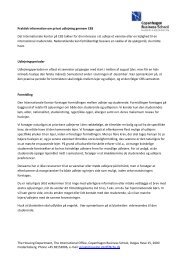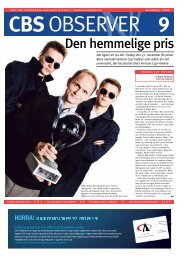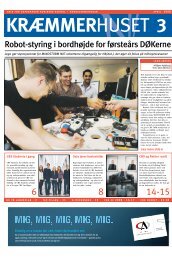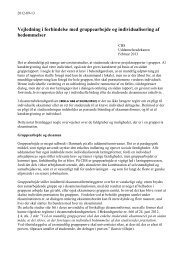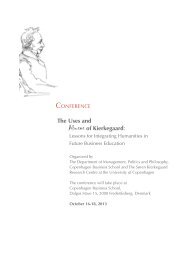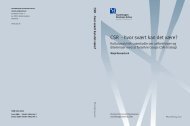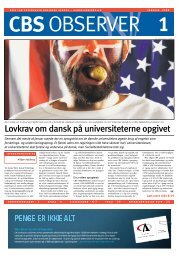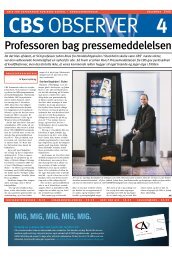Untitled - CBS Observer
Untitled - CBS Observer
Untitled - CBS Observer
You also want an ePaper? Increase the reach of your titles
YUMPU automatically turns print PDFs into web optimized ePapers that Google loves.
From bean to bar<br />
– an overview of the<br />
14<br />
<strong>CBS</strong> CASE COMPETITION 2013<br />
Cocoa beans are seeds of the theobroma cacao, a tree<br />
that derives its name from the Greek words for “food of<br />
the gods.” After the cocoa beans are harvested, they go<br />
through a series of steps, namely fermenting and drying,<br />
that are essential to developing the cocoa flavor. This process<br />
takes time and knowledge, and thus acts as a differentiating<br />
factor in cocoa bean quality. Nevertheless, most<br />
cocoa beans produced worldwide today come from small,<br />
simple farms in Western Africa and Indonesia, from which<br />
they are gathered by middlemen in increasingly larger<br />
batches until they reach the chocolate manufacturer. It is<br />
therefore easy to imagine that chocolate manufacturers receive<br />
very heterogeneous shipments of cocoa beans. As a<br />
result of cocoa batch mixing, the chocolate manufacturer<br />
loses transparency regarding the quality of raw materials<br />
and, perhaps worse, the circumstances under which the<br />
cocoa beans were produced.<br />
Traceability has become the very core principle of Toms’<br />
supply chain. Since 2009, Toms has had full traceability on<br />
all its cocoa beans from Ghana. To ensure traceability, Toms<br />
sources its products from sustainable producers in Ghana<br />
through unique partnerships with Armajaro, Source Trust and<br />
the Cocoa Research Institute of Ghana. These partnerships<br />
allow Toms to trace each individual bag of cocoa beans back<br />
to the farmer who produced them. In practice, this requires<br />
that Toms’ cocoa beans are marked, transported and stored<br />
chocolate supply chain Together with researchers from Copenhagen University<br />
and the Cocoa Research Institute of Ghana, Toms has<br />
The key ingredient in chocolate is cocoa. Cocoa beans are grown predominantly in less-developed coun-<br />
[Insert visual overview/flow chart of the supply chain]<br />
tries in Western Africa and Indonesia. Before they even reach the harbor docks where they are shipped for<br />
processing, cocoa beans have gone through a sequence of steps involving multiple actors from business,<br />
government and non-governmental organizations. Hence, the cocoa supply chain is significantly more<br />
complex than that of most other commodities. For a company of its size, Toms has taken a very unique<br />
approach to managing this complexity. In broad terms, Toms’ chocolate supply chain can be divided into<br />
four steps: origin, processing, manufacturing, and sales.<br />
Origin<br />
TRAY 10 TM Fermentation<br />
introduced an innovative way to improve the fermentation<br />
process. Instead of the traditional and inherently uneven<br />
fermentation process under banana leaves, beans are fermented<br />
on specially designed trays that are made locally.<br />
This method gives the finished chocolate product a much<br />
richer flavor. Chocolate made with TRAY 10 fermenting is<br />
currently sold under the brands A Xoco by Anthon Berg<br />
and Toms Extra<br />
separately before they are shipped from Ghana to Toms’ manufacturing<br />
facility in Denmark. Moreover, Toms works with a<br />
range of organizations to train farmers in sustainable farming<br />
practices and to educate children in the farming communities.<br />
Put differently, traceability is Toms’ way of ensuring a total<br />
product quality. Toms’ goal is to improve the quality of<br />
chocolate, whilst improving the everyday lives of its cocoa<br />
farmers. This means ensuring long-term sustainability in the<br />
communities from which the cocoa beans are sourced. Of<br />
course both sustainability and traceability come at a cost.<br />
Toms currently pays a premium of approximately 10 percent<br />
on its cocoa beans, the majority of which is returned to the<br />
local cocoa communities.<br />
Processing<br />
Unprocessed cocoa beans are transported from Ghana right<br />
to Toms’ factory doors. This brings the cocoa beans to the<br />
next step of the supply chain: processing. Processing covers<br />
all the activities that are needed to transform cocoa beans<br />
into semi-finished industrial chocolate, also known as couverture.<br />
In this step, cocoa beans are roasted to give the final<br />
touch of flavor. They are then ground and pressed to extract<br />
cocoa butter and powder. Finally, the cocoa ingredients are<br />
mixed with other ingredients to make chocolate.<br />
15




